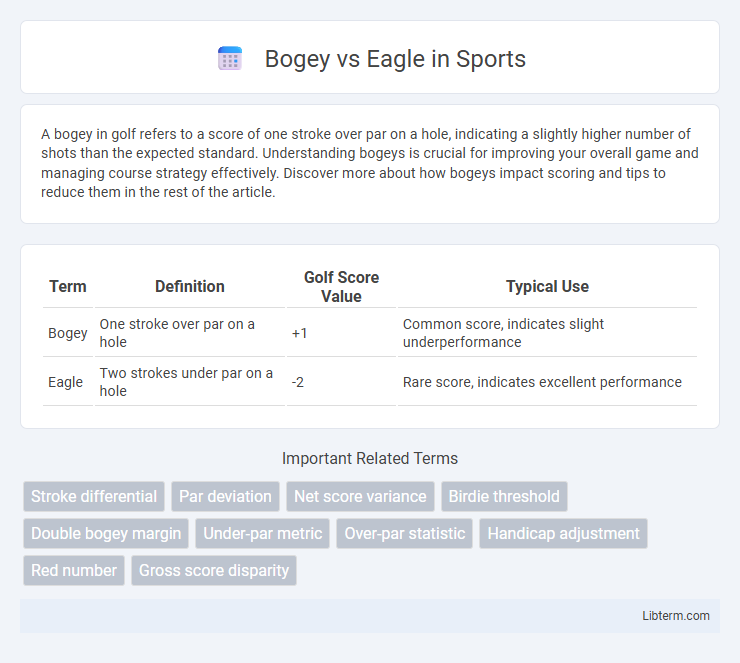A bogey in golf refers to a score of one stroke over par on a hole, indicating a slightly higher number of shots than the expected standard. Understanding bogeys is crucial for improving your overall game and managing course strategy effectively. Discover more about how bogeys impact scoring and tips to reduce them in the rest of the article.
Table of Comparison
| Term | Definition | Golf Score Value | Typical Use |
|---|---|---|---|
| Bogey | One stroke over par on a hole | +1 | Common score, indicates slight underperformance |
| Eagle | Two strokes under par on a hole | -2 | Rare score, indicates excellent performance |
Understanding Golf Scoring: What Are Bogey and Eagle?
Bogey and eagle are key golf scoring terms representing strokes relative to par on a given hole, with a bogey indicating one stroke over par and an eagle denoting two strokes under par. Understanding these scores helps golfers gauge performance, as a bogey typically reflects a modest challenge on the course, while an eagle signifies exceptional play and skill. Mastery of bogey and eagle concepts is essential for analyzing game strategy and improving overall scoring in golf.
The Meaning of Bogey in Golf
A bogey in golf signifies a score of one stroke over par on a given hole, reflecting a slight underperformance compared to the expected standard. This scoring term helps golfers track progress and adjust strategies to improve overall performance. Understanding the concept of a bogey is essential for comparing it to an eagle, which represents a score two strokes under par, highlighting a striking contrast in scoring achievement.
Explaining Eagle: A Golfer’s Achievement
An eagle in golf signifies a score of two strokes under par on a single hole, indicating exceptional skill and precision. Achieving an eagle typically involves sinking a long putt or completing a hole in fewer shots than an expert player's standard. This rare accomplishment boosts a golfer's score significantly and demonstrates mastery of challenging course conditions.
How to Score a Bogey: Common Scenarios
Scoring a bogey typically occurs when a golfer completes a hole in one stroke over par, often due to missed greens or difficult hazards. Common scenarios include missing approach shots, leading to challenging chip-ins or longer putts, or encountering trouble from bunkers or water hazards. Managing recovery shots effectively and minimizing additional strokes after initial mistakes are key strategies to limit the score to a bogey rather than higher.
Strategies to Achieve an Eagle on the Course
Achieving an eagle on the golf course requires precise course management and aggressive shot making, including selecting a driver or long iron off the tee to set up a reachable green in fewer strokes. Understanding hole layout and wind conditions allows golfers to optimize distance and accuracy for approach shots, aiming to land the ball within close range of the pin for a two-putt or better. Practice in controlling trajectory, spin, and green reading enhances scoring opportunities, making an eagle a realistic target over bogey.
Psychological Impact: Bogey vs Eagle on Players
A bogey significantly increases a golfer's stress and self-doubt, impacting focus and confidence during play. In contrast, scoring an eagle boosts morale, reinforces positive mindset, and enhances momentum through psychological reinforcement. The stark difference between these scores can shift a player's mental state, influencing performance consistency and decision-making on the course.
Differences in Difficulty: Bogey Compared to Eagle
A bogey in golf represents a score of one stroke over par on a hole, indicating a moderate level of difficulty where the player faces minor challenges. An eagle, on the other hand, is achieved by scoring two strokes under par, reflecting a significantly higher skill level and mastery over the hole's challenges. The difficulty difference lies in the precision and control required to achieve an eagle versus managing errors to avoid a bogey.
Famous Bogey and Eagle Moments in Golf History
In golf history, Famous Bogey moments often highlight the resilience and perseverance of iconic players like Tiger Woods, who turned potential disaster into recovery under pressure. Eagle moments, exemplified by Jack Nicklaus's legendary double eagles at the Masters, showcase skill and precision that drastically shift the momentum in major tournaments. These memorable instances emphasize the dramatic contrasts and emotional highs that define professional golf's most thrilling competitions.
Improving Your Game: Avoiding Bogeys, Aiming for Eagles
Improving your golf game requires minimizing bogeys by enhancing short game precision and course management skills. Focus on consistent swing mechanics and accurate putting to avoid unnecessary strokes that lead to bogeys. Aim for eagles by mastering long drives and capitalizing on scoring opportunities on par-5 holes through strategic shot placement.
Frequently Asked Questions: Bogey vs Eagle in Golf
Bogey in golf refers to a score of one stroke over par on a hole, while an eagle is two strokes under par, representing significantly better performance. Common questions include how bogeys impact handicap calculations and whether achieving an eagle can substantially lower a player's score per round. Understanding the frequency of bogeys versus eagles helps golfers set realistic goals and improve scoring strategies on various course difficulties.
Bogey Infographic

 libterm.com
libterm.com